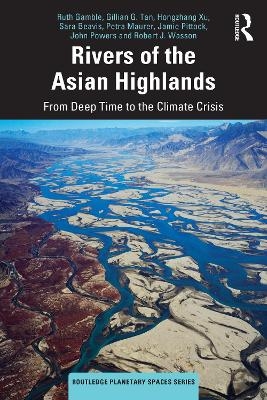
Rivers of the Asian Highlands
Routledge (Verlag)
978-1-032-49058-8 (ISBN)
Rivers of the Asian Highlands introduces readers to the intersecting headwaters of Asia’s eight largest rivers, focusing on the upper reaches of two river systems: the Brahmaputra’s highland tributaries in the eastern Himalayan Mountains and the Dri Chu (upper Yangzi), which descends from the Tibetan Plateau’s east through the Hengduan Mountains.
This book guides its readers through these two rivers’ physical, environmental, cultural, social, and political histories before providing a multifaceted assessment of their present. It uses general and detailed insights from multiple disciplines, including anthropology, conservation, geography, geomorphology, climate science, ecology, history, hydrology, and religious studies. The rivers’ stories explain how the catchments’ hazards—earthquakes, landslides, floods, droughts, and erosion—interact with their energetic, hydrological, ecological, cultural, and social abundance.
This book’s multiple cultural and disciplinary perspectives on the rivers will interest anyone who wants to understand the rivers of this critically important region as the environment faces climate change and other ecological crises.
Ruth Gamble is a senior lecturer in history and environmental humanities in the Department of Archaeology and History at La Trobe University in Melbourne, Australia. She is an environmental and cultural historian of Tibet and the Himalaya. She has previously worked on the Himalaya and Tibet’s sacred geography and is writing a book on the environmental history of the Yarlung Tsangpo River. Gillian G. Tan is a senior lecturer in anthropology at the School of Humanities and Social Sciences at Deakin University in Geelong, Australia. Her research covers the multiple ways humans relate with their natural environment and focuses on the cultural and environmental changes experienced by nomadic pastoralists of the eastern Tibetan plateau. Her current work explores the intersections between religion and ecology. Hongzhang Xu is a postdoctoral fellow at the Mathematical Sciences Institute, Australian National University in Canberra, Australia. He specializes in transdisciplinary research and explores societal adaptation to changes through power relations, cultural values, and institutional dynamics. His focus includes Aboriginal and Torres Strait Islander mathematics and sciences, and he has additional expertise in biodiversity, water management, and Indigenous knowledge. Sara Beavis is a senior lecturer at the Fenner School of Environment and Society, Australian National University in Canberra, Australia. She has a background in environmental geology with a focus on water. Her research explores the impacts of anthropogenic and natural processes, including land use and climate variability and change on streamflows and water quality, and the cascading consequences these have for downstream river systems, water-dependent ecosystems, and human communities. Petra Maurer is a professor at the Institute of Indology and Tibetology, Ludwig Maximilian University in Munich, Germany. Her research focuses on the cultural history of Tibet, particularly on divination, medicine, and lexicography. She compiles the Wörterbuch der Tibetischen Schriftsprache at the Bavarian Academy of Sciences and Humanities. Jamie Pittock is a professor at the Fenner School of Environment and Society, Australian National University in Canberra, Australia. His background includes research into the integration between management of freshwater ecosystems and responses to climate change, involving case studies from nine countries. His current research focuses on environmental governance, climate change adaptation, energy, and the sustainable management of water. John Powers is a fellow of the Australian Academy of Humanities and currently holds a joint position in the School of Historical and Philosophical Studies and the Centre for Contemplative Studies at the University of Melbourne in Melbourne, Australia. His research includes works on Buddhist epistemology and Yogācāra soteriology, Chinese government propaganda on Tibetan Buddhism, gender in Indian Buddhism, and human rights issues. Robert J. Wasson is an emeritus professor at the Australian National University and an adjunct at James Cook University, Cairns, Australia. He is a geomorphologist with expertise in reconstructing landscape change over long periods, catchment processes and management, sediment and nutrient budgeting, extreme flood hydrology and its geomorphic expression and mitigation, and the impact of climate variability and change on fluvial systems. He has undertaken research in many parts of Australia and Asia.
Introduction. River Views
Chapter 1. Mountain Rivers
1a. Gravitational Potential Energy and Stream Power
1b. Highland Origin Stories
Chapter 2. Climatic Rivers
2a. Large Floods, GLOFs and LLOFs
2b. Lu and Water
Chapter 3. Frozen Rivers
3a. Dust and Sand: Wind Action on the Tibetan Plateau
Chapter 4. Living Rivers
4a. Defining Wetlands
Chapter 5. Human Rivers
5a. Human-Fish Relations in the Highlands
Chapter 6. Agro-Pastoral Rivers (co-written by Kelzang T. Tashi)
6a. The Chuzhi (Four Rivers) (co-written by Lhamo Khyab)
Chapter 7. Territorializing Rivers (co-written by Dechen Palmo and Alexander Davis)
Chapter 8. Managing Rivers
8a. Ecological Systems Services
8b. Anti-Hydropower Protests in Sikkim
Chapter 9. States, NGOs and Rivers
9a. Fish Conservation in Yunnan
9b. Black-neck Crane Conservation in Bhutan
Conclusion. Mountain Flows: Frontiers, Borders, Equations
Appendix. River Names
Bibliography
| Erscheinungsdatum | 19.10.2024 |
|---|---|
| Reihe/Serie | Routledge Planetary Spaces Series |
| Zusatzinfo | 5 Tables, black and white; 32 Line drawings, black and white; 32 Halftones, black and white; 64 Illustrations, black and white |
| Verlagsort | London |
| Sprache | englisch |
| Maße | 156 x 234 mm |
| Gewicht | 630 g |
| Themenwelt | Naturwissenschaften ► Geowissenschaften ► Geografie / Kartografie |
| Naturwissenschaften ► Geowissenschaften ► Hydrologie / Ozeanografie | |
| Naturwissenschaften ► Geowissenschaften ► Meteorologie / Klimatologie | |
| Technik ► Elektrotechnik / Energietechnik | |
| Technik ► Umwelttechnik / Biotechnologie | |
| ISBN-10 | 1-032-49058-6 / 1032490586 |
| ISBN-13 | 978-1-032-49058-8 / 9781032490588 |
| Zustand | Neuware |
| Haben Sie eine Frage zum Produkt? |
aus dem Bereich


